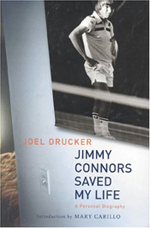Curiosity: A New Federer Biography Can Help You Play Better Tennis
Joel Drucker

In the halls of an imaginary Tennis University, there surely is a department known as "Federer Studies." No player in tennis history has been so extensively dissected.
Instructors have devoted thousands of hours picking apart his strokes, from the ultra-smooth forehand and sculpted service motion, to the highly stylized way Federer's eyes remain focused on the contact point well after he's hit the ball. To see high speed footage of Federer's game in the Tennisplayer High Speed Archive Click Here.)
This past August marked the publication of what I believe will stand the test of time as the definitive book on Federer, Christopher Clarey's The Master: The Long Run and Beautiful Game of Roger Federer. (Click Here.)
It's notable for many reasons, but for me especially for what it says to all players at all levels about developing their games. Federer's curiosity and openness to everything about tennis, and especially the entire range of possibilities about how to play a truly complete game. It makes this biography a lesson.
History
Historians have of course previously charted his career arc, including a compelling book authored by Randy Walker called The Days of Roger Federer, and then Jon Wertheim's superb Strokes of Genius, a deep dive into the incredible 2008 Wimbledon final between Federer and Rafael Nadal.
There have also been conventional biographies, authored by such accomplished journalists as Chris Bowers and Rene Stauffer. On a more quirky basis, there's William Skidelsky's first-person tale, Federer and Me: A Story of Obsession. (Click Here to read a series of excerpts on Tennisplayer.)
And then there is Footsteps of Federer: A Fan's Pilgrimage Across 7 Swiss Cantons in 10 Acts, authored by Dave Seminara.

There are also dozens of articles. Arguably the most notable is the late David Foster Wallace's New York Times piece, Federer as a Religious Experience. From instruction to history to theology, the "Federer Studies" department covers the gamut.
Clarey
As the New York Times' primary tennis writer for more than 20 years, Clarey has tracked Federer's entire career.
He witnessed the 17-year-old Federer's first appearance at a major, has subsequently been present for virtually every other Federer match of note and conducted one-on-one interviews with him more than 20 times, in places and spaces all over the world. That level of access and accrued rapport is rare these days, a time when media outlets are shriveling and chances to speak up close with athletes have become increasingly rare.
This is a comprehensive history. Clarey provides engaging and well-informed accounts of all of Federer's major triumphs. Describing Federer's immensely satisfying run to the 2017 Australian Open title – his first major victory in more than four years – Clarey writes, "Federer was committed to reducing his use of the backhand slice and his use of the blocked return. He needed to keep Nadal off balance, to deprive him of the time to set up properly for his own world-class forehand."

Clarey's analysis is aided by the fact that he played varsity tennis at Williams College and therefore has a keen awareness of how matches are won and lost. Believe me, I've seen first-hand how that kind of first hand knowledge is not present among a great many tennis writers.
This thoughtful book is also propelled by Clarey's keen observation skills. Having sat next to him a number of times in the press section of tournaments, I've been able to see first-hand how diligently Clarey takes notes and pays attention to everything from the players and patterns of play, to the weather, the crowd and any other factor that will affect the ebb and flow of the match.
He's also at the head of the pack when it comes to gathering information before and after matches from coaches and other significant sources. Pay attention like this under deadline pressure for decades and your analytical skills become razor-sharp.
There are also assessments of Novak Djokovic and Rafael Nadal. Writes Clarey, "Djokovic, from my point of view, is the most fascinating of the men who have hoarded the loot in this golden era of tennis. He is a bespoke, bristle-haired blend of generosity and bellicosity who seems as committed to raking his inner Zen garden as he is to ripping his own tennis shirt in two after converting match point."

Peter Carter
Woven into Federer's competitive journeys are details on his coaches, including a keen analysis on the man that shaped him as a youth, Peter Carter, an Australian who tragically died in 2002. A former top 200 player, Carter's wide range of shots and styles strongly shaped Federer's view of how to build a playing style.
There are also thoughts on other Federer coaches Peter Lundgren, Tony Roche, Jose Higueras, Paul Annacone, Stefan Edberg, Ivan Ljubicic, and Severin Luthi. Each of these wise tennis minds provided Federer with many ideas and, most notably, share the quality of being rather tranquil in manner. You won't see any screamers on the Federer team.
Ceaseless Appetite

But for those who play tennis zealously – regardless of skill level – major lessons might well best come from Federer himself, most notably in the form of his love for the game and ceaseless appetite about its history and meaning. "I wish that all the youngsters coming up on the tour will be super, super curious to find out everything about tennis," Clarey quotes him as saying.
"Like the records of Arthur Ashe. Why Jimmy Connors? Why Martina Navratilova? Why Gabriela Sabatini? You name it. Just to know what's so interesting about these people because everybody has a super interesting story, every single player. They don't have to be former world number ones."
That profound level of interest might well explain what makes Federer's game so captivating and has allowed him to compete so well these many years. If you ponder lots of players with such enthusiasm, particularly in your formative years, it's a logical next step to try and emulate them – a spin here, a volley there, a serve to one corner this way, a service return another way, a drop shot approach and so on. Engage in tennis like Federer and it's hard to imagine getting bored.
The Gestalt
Federer's gestalt is a vivid contrast to the tales one hears of players who mostly learn to crack one groundstroke after another and soon enough find tennis monotonous.

This was never the case for Federer. He let his curiosity drive him, along the way pursuing mastery of so many letters of the tennis alphabet. Granted, it also helps that Federer had the hand-eye coordination and body awareness to attempt those shots and soon enough begin to make them. For all the talk of process as valuable in its own right, few things validate an effort more than a positive outcome.
But the bigger point to be gained from this book has to do with how one goes about playing tennis. No matter how good you are, why not think about the sport the way Federer does?
So many players limit themselves, settling quickly for techniques and tactics that let them compete at one level. And then they stop. Consider these many still-born tennis journeys: The proficient 12-year-old who never learns to volley.
The 3.5 who never learns to serve with a backhand grip. The 16-year-old who never gains proficiency with a slice backhand. The 4.0 who only plays doubles and always returns in the ad court.
On and on it goes. Parallel to the playing world are the many instructors who teach narrowly, lessons often focused on hitting one groundstroke after another.

And then there's Roger Federer, the man who has generated so much swooning. Why not emulate his quest for the broadest array possible? Why not hit a backhand drive and slice in the same rally?
Or attempt a drop shot approach shot? Or ask an instructor to teach you how to come to net off a return of serve? Or even experiment with the SABR as Roger did later in his career?
As Clarey's book points out frequently, the more Federer ages, the younger he becomes, the eternal racquet-wielding child, aware that most of all, tennis is a game; tennis less about work and more about play. It's hard to believe there will ever be a book about Federer that offers as close a portrait of an athlete who brings something even more cherished than skill to his craft: joy.





